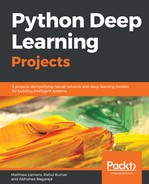Welcome to our first proper project in Python Deep Learning! What we'll be doing today is building a classifier to solve the problem of identifying specific handwriting samples from a dataset of images. We've been asked (in this hypothetical use case) to do this by a restaurant chain that has the need to accurately classify handwritten numbers into digits. What they have their customers do is write their phone numbers in a simple iPad application. At the time when they can be seated, the guest will get a text prompting them to come to see the restaurant's host. We need to accurately classify the handwritten numbers so that the output can be the accurately predicted labels for the digits of a phone number. This can then be sent to their (hypothetical) auto dialer service for text messages and the notice gets to the right hungry customer!
The data science approach to the problem of classification can be configured in a number of ways. In fact, later in this book, we'll look at how to increase the accuracy in image classification with convolutional neural networks.
Let's start with the baseline deep neural network model architecture. We will get our intuition and skills firmly established and this will prepare us for learning more complex architectures to solve a wider variety of problems as we go progress through the projects in this book.
What we'll learn in this chapter is:
- What is a Multilayer Perceptron?
- Explore a common open source handwriting dataset - The MNIST dataset
- Build our intuition and preparations for model architecture
- Code the model and define hyperparameters
- Build the training loop
- Test the model!
